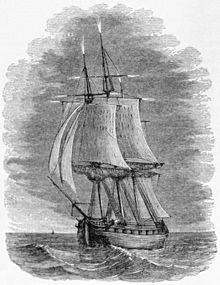
Back Sint-Elmusvuur Afrikaans شرر القديس إلمو Arabic Fueu de San Telmo AST Kalayo ni San Elmo BCL Агні Святога Эльма Byelorussian Огън на свети Елм Bulgarian Foc de Sant Elm Catalan Eliášův oheň Czech Sanktelmsild Danish Elmsfeuer German


St. Elmo's fire (also called witchfire or witch's fire[1]) is a weather phenomenon in which luminous plasma is created by a corona discharge from a rod-like object such as a mast, spire, chimney, or animal horn[2] in an atmospheric electric field. It has also been observed on the leading edges of aircraft, as in the case of British Airways Flight 009, and by US Air Force pilots.[3]
The intensity of the effect, a blue or violet glow around the object, often accompanied by a hissing or buzzing sound, is proportional to the strength of the electric field and therefore noticeable primarily during thunderstorms or volcanic eruptions.
St. Elmo's fire is named after St. Erasmus of Formia (also known as St. Elmo), the patron saint of sailors. The phenomenon, which can warn of an imminent lightning strike,[4] was regarded by sailors with awe and sometimes considered to be a good omen.[5][6]
- ^ Jeffreys, M.D.W. (Jun., 1949), "Witch's Fire", in Folklore; Vol. 60, No. 2, pp. 286–290 (5 pages); Pub: Taylor & Francis, Ltd.
- ^ Heidorn, Keith C. (30 May 1998). "Weather Phenomenon and Elements: The Fire Of St. Elmo". Retrieved 6 November 2023.
- ^ "Pilots capture rare weather phenomenon from cockpit (video: 00:25)". BBC News. 29 August 2023. Retrieved 9 September 2023.
- ^ Davis C, Engeln A, Johnson EL, et al. (December 2014). "Wilderness Medical Society practice guidelines for the prevention and treatment of lightning injuries: 2014 update". Wilderness & Environmental Medicine. 25 (4 Suppl): S86–95. doi:10.1016/j.wem.2014.08.011. PMID 25498265.
- ^ Eyers, Jonathan (2011). Don't Shoot the Albatross!: Nautical Myths and Superstitions. London: A&C Black. ISBN 978-1-4081-3131-2.[page needed]
- ^ Bergreen, Laurence (2003). Over the Edge of the World: Magellan's Terrifying Circumnavigation of the Globe. New York: Morrow. ISBN 978-0-06-621173-2.[page needed]